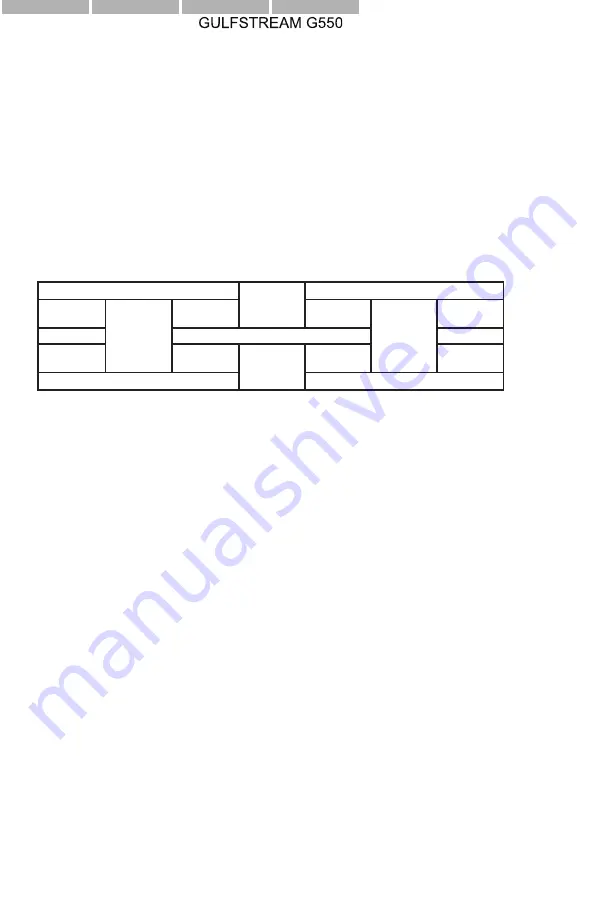
actuator.
Four pressure switches monitor left and right hydraulic system pressures
within the pistons of the rudder actuator. In normal conditions, all four
switches sense stabilized pressures since hydraulic outputs positioning the
rudder are balanced by air load pressures on the rudder surface acting
against actuator pressures. When a malfunction occurs and the rudder
moves contrary to the commanded direction, the hydraulic actuator shaft
moves in the contrary direction, causing an increase in hydraulic pressure
on the opposite sides of the pistons within the actuator. The left and right
system opposite side pressure switches close, completing the circuit
initiated by closure of the bracket plunger switches, and an electrical signal
is sent to a timing relay. If the contrary rudder movement persists for longer
than one half (½) second, hydraulic pressure from both left an right
systems is shut off from the rudder actuator.
Left Hydraulic System
Right Hydraulic System
Left
Rudder
←
Right
Rudder
→
Left
Rudder
←
Right
Rudder
→
Hydraulic Actuator Shaft
Pressure
Switch
Pressure
Switch
Pressure
Switch
Pressure
Switch
In a similar manner, if a hydraulic malfunction causes the shaft of the
actuator to move in a direction opposite the pilot or yaw damper / autopilot
commanded direction, the increased pressures in the wrong direction sides
of the pistons would close the monitoring switches, and movement of the
actuator shaft would cause the cam arm to contact the plunger switches on
the external bracket, and hydraulic pressure would be shut off to the rudder
actuator after a one half (½) second delay.
If a hydraulic malfunction in a single system (left or right) side of the
actuator moves the actuator shaft in a wrong direction, only the hydraulic
pressure of the malfunctioning system is shut off. For instance in a
stabilized rudder condition, if the left hydraulic system piston attempts to
move the actuator shaft to the right, the increased pressure in the right side
of the left piston will close the monitor switch and actuator shaft
displacement will close both the left and right hydraulic system bracket
plunger switches, completing the shut off circuit for the left hydraulic
system after a one half (½) second delay. (In this case hydraulic pressure
in the right rudder side of the right hydraulic system piston will decrease
due to the increase in area caused by actuator shaft movement.) The
rudder hydraulic actuator will continue to function using the remaining
hydraulic system. During single hydraulic system operation the pressure
regulator valve will open, allowing the remaining hydraulic system pressure
output to increase up to three thousand (3,000) psi for rudder actuation.
The operation of the hydraulic shut off valves by the HOPS is signaled to
MAU #2 over an ARINC-429 connection. The shut off condition is
monitored by the MWS, and a CAS message corresponding to the
condition is displayed on the CAS window. If both hydraulic systems are
shut off, an amber caution message of “Rudder Hydraulics Off” is
displayed. Manual rudder control may remain possible, depending upon
OPERATING MANUAL
PRODUCTION AIRCRAFT SYSTEMS
2A-27-00
Page 26
August 14/03
Title Page
Prev Page
Next Page
TOC
Summary of Contents for G550
Page 6: ...Title Page Prev Page Next Page TOC ...
Page 16: ...Title Page Prev Page Next Page TOC ...
Page 18: ...Title Page Prev Page Next Page TOC ...
Page 20: ...Title Page Prev Page Next Page TOC ...
Page 32: ...Title Page Prev Page Next Page TOC ...
Page 44: ...Title Page Prev Page Next Page TOC ...
Page 46: ...Title Page Prev Page Next Page TOC ...
Page 54: ...Title Page Prev Page Next Page TOC ...
Page 58: ...Title Page Prev Page Next Page TOC ...
Page 60: ...Title Page Prev Page Next Page TOC ...
Page 68: ...Title Page Prev Page Next Page TOC ...
Page 80: ...Title Page Prev Page Next Page TOC ...
Page 82: ...Title Page Prev Page Next Page TOC ...
Page 84: ...Title Page Prev Page Next Page TOC ...
Page 86: ...Title Page Prev Page Next Page TOC ...
Page 88: ...Title Page Prev Page Next Page TOC ...
















































